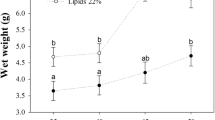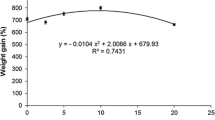Abstract
The effect of different lipid compositions of live feed on the survival, growth rate and pigmentation success of turbot larvae, Scophthalmus maximus (L.), was investigated. Rotifers, Brachionus plicatilis, together with the algae Tetraselmis sp., were administered until day 12, and Artemia was fed until day 27. The experimentally treated live feeds were enriched with four formulated emulsions, resulting in a gradient in the relative contents of Ω3 HUFA (highly unsaturated fatty acids) and in DHA (docosahexaenoic acid, 22:6 Ω3)/EPA (eicosapentaenoic acid, 20:5 Ω3) ratios in both the rotifers and Artemia.
There were no differences in larval growth rate, and only small differences in survival rate throughout the feeding experiment, probably because of satisfactory levels of Ω3 HUFA in the live feed to sustain growth and survival. A correlation was obtained between the percentage of completely pigmented 27 d old turbot and the DHA/EPA ratio in the total lipids of 12 d old larvae, which again was correlated with the corresponding ratio in the live feed used. The results suggest that normal pigmentation in turbot requires dietary DHA in the early larval feeding period, and that this requirement cannot be replaced by EPA.
Similar content being viewed by others
References
Bazan, N.G. (1990) Supply of n-3 polyunsaturated fatty acids and their significance in the central nervous system. In: Nutrition and the Brain, Vol. 8, (eds R.J. Wurtman and J.J. Wurtman) Raven Press, Ltd: New York, NY, pp. 1–24.
Bell, M.V. and Dick, J.R. (1993) The appearance of rods in the eyes of herring and increased docosahexaenoyl molecular species of phospholipids. Journal of the Marine Biological Association of the United Kingdom 73, 679–688.
Bell, M.V. Henderson, R.J., Pirie, B.J.S. and Sargent, J.R. (1985) Effect of dietary polyunsaturated fatty acid deficiencies on mortality, growth and gill structure in the turbot Scophthalmus maximus. Journal of Fish Biology 26, 181–191.
Ben-Amotz, A., Fishler, R. and Schneller, A. (1987) Chemical composition of dietary species of marine unicellular algae and rotifers with emphasis on fatty acids. Marine Biololgy 95, 31–36.
Bligh, E.G. and Dyer, W.J. (1959) A rapid method of total lipid extraction and purification. Canadian Journal of Biochemistry and Physiology 37, 911–917.
Corcobado Oñate, F., Coo, A., Arnaiz, R., Amoedo, F. and Rua, N. (1991) Daily ration of turbot larvae, Scophthalmus maximus, in intensive culture. In: Larvi'91 — Fish & Crustacean Larviculture Symposium (eds P. Lavens, P. Sorgeloos, E. Jaspers and F. Ollevier) Special Publication 15, European Aquaculture Society: Gent, Belgium, pp. 119–121.
Cowey, C.B., Owen, J.M., Adron, J.W. and Middleton, C. (1976) Studies on the nutrition of marine flatfish. The effect of different dietary fatty acids on growth and fatty acid composition of turbot, Scophthalmus maximus. British Journal of Nutrition 36, 479–486.
Gatesoupe, F.J., Léger, C., Métailler, R. and Luquet, P. (1977) Alimentation lipidique du turbot (Scophthalmus maximus L.) 1. Influence de la longueur de chaine des acides gras de la série Ω3. Annales d'Hydrobiologie 8, 89–97.
Guillard, R.R.L. and Ryther, J.H. (1962) Studies of marine planktonic diatoms. I. Cyclotella nana Hustedt, and Detonula confervacea (Cleve) Gran. Canadian Journal of Microbiology 8, 229–239.
Howell, B.R. (1979) Experiments on the rearing of larval turbot, Scophthalmus maximus L. Aquaculture 18, 215–225.
Izquierdo, M.S., Arakawa, T., Takeuchi, T., Haroun, R. and Watanabe, T. (1992) Effect of n-3 HUFA levels in Artemia on growth of larval Japanese flounder (Paralichthys olivaceus). Aquaculture 105, 73–82.
Jones, A., Prickett, R.A. and Douglas, M.T. (1981) Recent developments in techniques for rearing marine flatfish larvae, particularly turbot (Scophthalmus maximus L.), on a pilot commercial scale. Rapports et Procès-Verbaux des Réunions Conseil International pour l'Exploration de la Mer 178, 522–526.
Kanazawa, A. (1985) Essential fatty acid and lipid requirement of fish. In: Nutrition and Feeding in Fish (eds C.B. Cowey, A.M. Mackie and J.G. Bell) Academic Press: London, pp. 281–298.
Kanazawa, A. (1991) Nutritional mechanisms causing abnormal pigmentation in cultured marbled sole larvae, Limanda yokohamae (Heterosomata). In:Larvi'91 — Fish & Crustacean Larviculture Symposium (eds P. Lavens, P. Sorgeloos, E. Jaspers and F. Ollevier) Special Publication 15, European Aquaculture Society: Gent, Belgium, pp. 20–22.
Kawamura, G. and Ishida, K. (1985) Changes in sense organ morphology and behaviour with growth in the flounder Paralichtys olivaceus. Nippon Suisan Gakkaishi 51, 155–165.
Kilham, S. (1978) Nutrient kinetics of freshwater planktonic algae using batch and semicontinuous methods. Internationale Vereinigung fuer Theoretische und Angewandte Limnologie 21, 147–157.
Koven, W.M., Tandler, A., Kissil, G.W. and Sklan, D. (1992) The importance of n-3 highly unsaturated fatty acids for growth in larval Sparus aurata and their effect on survival, lipid composition and size distribution. Aquaculture 104, 91–104.
Le Milinaire, C. (1984) Etude du besoin en gars essensiels pour la larve de turbot (Psetta maxima L.) pendant la phase d'alimentation avec le rotifers Brachionus plicatilis O.F. Müller. Thèse 3eme cycle, Université Bretagne Occidentale, 167 pp.
Le Milinaire, C., Gatesoupe, F.J. and Stephan, G. (1983) Approche du besoin quantitatif en acides gras longs polyinsaturatés de la serie n-3 chez la larve de turbot (Scophthalmus maximus). Comptes Rendus de l'Academie des Sciences Paris 296, 917–920.
Linares, F. and Henderson, R.J. (1991) Incorporation of 14C-labelled polyunsaturated fatty acids by juvenile turbot, Scophthalmus maximus (L.) in vivo. Journal of Fish Biology 38, 335–347.
Metcalfe, L.D., Schimtz, A.A. and Pelka, J.R. (1966) Rapid preparation of fatty acid esters from lipids for gas chromatography. Analytical Chemistry 38, 514–515.
Mourente, G. and Odriozola, J.M. (1990) Effect of broodstock diets on lipid classes and their fatty acid composition in eggs of gilthead sea bream (Sparus aurata L.). Fish Physiology and Biochemistry 8, 93–101.
Neuringer, M., Anderson, G.J. and Connor, W.E. (1988) The essentiality of n-3 fatty acids for the development and function of the retina and brain. Annual Review of Nutrition 8, 517–541.
Olsen, Y., Rainuzzo, J.R., Reitan, K.I. and Vadstein, O. (1993a) Manipulation of lipids and Ω3 fatty acids in Brachionus plicatilis. In: Proceedings of the First International Conference on Fish Farming Technology, Trondheim, Norway, 9–12 August 1993 (eds H. Reinertsen, L.A. Dahle, L. Jørgensen and K. Tvinnereim) Rotterdam: A.A. Balkema pp. 101–108.
Olsen, Y., Reitan, K.I. and Vadstein, O. (1993b) Dependence of temperature on loss rate of rotifers, lipids, and Ω3 fatty acids in starved Brachionus plicatilis cultures. Hydrobiologia 255/256, 13–20.
Owen, J.M., Adron, J.W., Sargent, J.R. and Cowey, C.B. (1972) Studies on the nutrition of marine flatfish. The effect of dietary fatty acids on the tissue fatty-acids of the plaice Pleuronectes platessa. Marine Biology 13, 160–166.
Pagliarani, A., Pirini, M., Trigari, G. and Ventrella, V. (1986) Effect of diets containing different oils on brain fatty acid composition in sea bass (Dicentrarchus labrax L.). Comparative Biochemistry and Physiology 83B, 277–282.
Paulsen, H. (1987) Current status of turbot culture. In: Proceedings of the Third International Symposium on Reproductive Physiology of Fish, St. John's, Newfoundland, Canada, August 1987 (eds R. Idler, L.W. Crim and J.M. Walsh) pp. 85–89, University of Newfoundland, Canada.
Rainuzzo, J.R., Reitan, K.I., Jørgensen, L. and Olsen, Y. (1993a) Lipid composition in turbot larvae fed live feed cultured by emulsions of different lipid classes. Comparative Biochemistry and Physiology B, in press.
Rainuzzo, J.R., Reitan, K.I. and Olsen, Y. (1994b) Effect of short and long term lipid enrichment on total lipids, lipid class and fatty acid composition in rotifers. Aquaculture International 2, 19–32.
Reitan, K.I., Rainuzzo, J.R., øie, G. and Olsen, Y. (1993) Nutritional effects of algal addition in first-feeding of turbot larvae. Aquaculture 118, 257–75.
Scott, A.P. and Middleton, C. (1979) Unicellular algae as food for turbot (Scophthalmus maximus L.) larvae — the importance of dietary long-chain polyunsaturated fatty acids. Aquaculture 18, 227–240.
Seikai, T. (1985) Influence of feeding periods of Brazilian Artemia during larval development of hatchery-reared flounder Paralichthys olivaceus on the appearance of albinism. Nippon Suisan Gakkaishi 51, 521–527.
Seikai, T., Shimozaki, M. and Watanabe, T. (1987) Estimation of larval stage determining the appearance of albinism in hatchery-reared juvenile flounder Paralichthys olivaceus. Nippon Suisan Gakkaishi 53, 1107–1114.
Takeuchi, T., Toyota, M., Satoh, S. and Watanabe, T. (1990) Requirement of juvenile red seabream Pagrus major for eicosapentaenoic and docosahexaenoic acids. Nippon Suisan Gakkaishi 56, 1263–1269.
Tocher, D.R. and Harvie, D.G. (1988) Fatty acid composition of the major phosphoglycerides from fish neural tissues; (n-3) and (n-6) polyunsaturated fatty acids in rainbow trout (Salmo gairdneri) and cod (Gadus morhua) brains and retinas. Fish Physiology and Biochemistry 5, 229–239.
Watanabe, T., Izquierdo, M.S., Takeuchi, T., Satoh, S. and Kitajima, C. (1989) Comparison between eicosapentaenoic and docosahexaenoic acids in term of essential fatty acid efficacy in larval red seabream. Nippon Suisan Gakkaishi 55, 1635–1640.
Whyte, J.N.C. and Nagata, W.D. (1990) Carbohydrate and fatty acid composition of the rotifer, Brachionus plicatilis, fed monospecific diets of yeast or phytoplankton. Aquaculture 89, 263–272.
Witt, U., Quantz, G., Kuhlmann, D. and Kattner, G. (1984) Survival and growth of turbot larvae Scophthalmus maximus L. reared on different food organisms with special regards to long-chain polyunsaturated fatty acids. Aquacultural Engineering 3, 177–190.
Author information
Authors and Affiliations
Rights and permissions
About this article
Cite this article
Reitan, K.I., Rainuzzo, J.R. & Olsen, Y. Influence of lipid composition of live feed on growth, survival and pigmentation of turbot larvae. Aquacult Int 2, 33–48 (1994). https://doi.org/10.1007/BF00118531
Issue Date:
DOI: https://doi.org/10.1007/BF00118531




